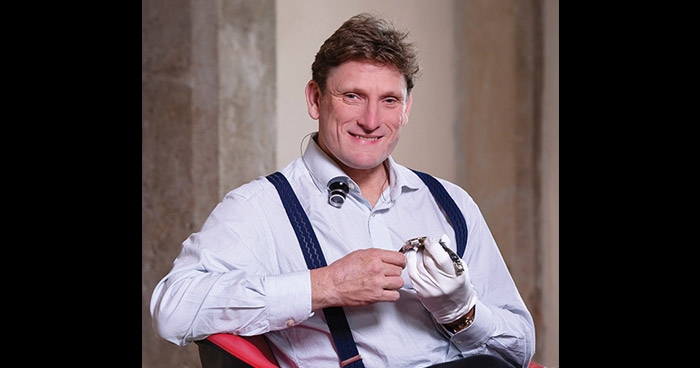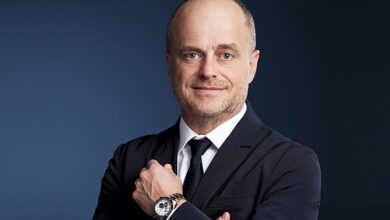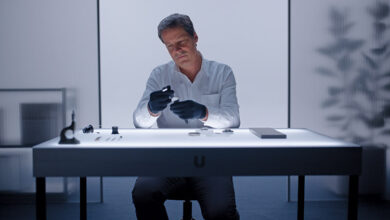Stephen Forsey reveals the secrets of Greubel Forsey’s 2016 novelties

Known as the other half of the distinguished duo that makes the young but highly respected Swiss independent brand, Greubel Forsey, ‘the’ Stephen Forsey talks to “Day & Night” magazine about the details of their current novelties that were revealed at the Salon International de la Haute Horlogerie (SIHH) 2016
The British-born passionate watch expert has been renowned from following his father’s passion in exploring the intricacies of watchmaking mechanics. Before his move to Switzerland, Stephen Forsey has already specialised in antique watch restoration, which led to a position as head of Asprey’s prestigious watch restoration department and he then furthered his horological education at WOSTEP. In 1992, Stephen joined Robert Greubel’s team at Renaud & Papi where he worked on the most complicated mechanical movements. Since then, Stephen Forsey has dedicated his time in furthering excellence in watchmaking, and in 1999, he found the opportunity to establish the CompliTime in partnership with Robert Greubel with the aim of creating and developing complicated mechanisms for high-end brands. Together, they then launched Greubel Forsey in 2004.
A young company, when compared to the legacy of the pillars of Swiss watchmaking, but Greubel Forsey persevered throughout its first decade, and the efforts and creativity have been well-paid. Last year, the independent watch brand garnered the highest award, Aiguille d’Or” Grand Prix award, for its “Vision” timepiece at the 2015 Grand Prix d’Horlogerie de Genève. Also, it has been famous for crafting the best models in the last decade: The Quadruple Tourbillon, Tourbillon 24 Secondes, Balancier Spiral Binôme, Différentiel d’Égalité, Double Balancier, and now the 7th invention that spectacularly celebrated the company's tenth anniversary, the Mechanical Computer of the QP à Équation.

In an exclusive interview during the SIHH 2016, Stephen Forsey shared with “Day & Night” magazine the essential details that went behind the creation of the Gruebel Forsey novelties for this year.
What is the idea behind introducing the Signature 1 at a new entry price point for a Greubel Forsey watch?
The Signature 1 is the new creation that answers a very difficult formula for us. Robert (Greubel) and I had been asking each other – and we also asked the team – if we can make an hour, minute and seconds only timepiece that incorporates all the Greubel Forsey codes together with the excellence in finishing and execution, but at the same time to offer this timepiece at the more accessible level compared to our previous collections. This was particularly a hard question to resolve but we did now, with Signature 1. Other than making it accessible in terms of the price point, this timepiece is actually featuring one of the rarest Greubel Forsey calibres since it will carry the movement that will only be of existence in 66 examples. In terms of development, Signature 1 will be released in a unique edition of 33 pieces in gold and platinum. In addition to this, 33 steel-cased pieces are available by advance order, thereby maintaining and reaffirming the rarity of our timepieces. Didier J.G. Cretin – a brilliant watchmaker and long-time team member at Greubel Forsey – has co-signed with us in introducing this new line, and we work together to simplify, refine and optimise the elements of this watch that shall carry along the same proportion of our previous collections.
Why did you choose to launch your first in-house balance wheel in Signature 1?
This watch is indeed showcasing a few firsts for Greubel Forsey. Aside from being our first watch available at an accessible price point, it also the first time in the history of Greubel Forsey to create a manually wound watch with three hands, featuring an exclusively designed Greubel Forsey balance wheel and a gold dial. Now, the idea of using our balance wheel has been under discussion between Robert and me for the past several years. Yet it was only four years ago when we had finally drawn and cemented the idea, but the problem was that we couldn’t find the right person outside the company that will meet our set criteria. We were not prepared to compromise on our design so the only choice was to invest in a team that would do it in-house. It was a big challenge since it involved many intricate processes especially that the balance wheel is considered as the heart of the movement. It required great precision and outstanding accuracy in every step of the processes which should be incredibly done to assure good results. As we perfected the processes, we felt that Signature 1 is an amazing opportunity to feature the first series of our in-house balance wheels. While we put in place the 18,000 gear train, it seemed it’s really the right moment since the massive balance wheel goes well with the architecture of a relatively smaller calibre.

How do you vision the growth of the Signature collection in the coming years?
No, the Signature timepiece has no commercial link. The concept is to allow a watchmaker to work with Robert and me at Greubel Forsey, and use his own idea and carry it out through the completion of the project. Drawing on our resources such as components, the watchmaker will operate following Greubel Forsey’s philosophy, and benefit from the skills and expertise specific to our watchmaking Atelier. This framework will guarantee our characteristic standards of excellence, both in terms of technical craftsmanship and aesthetics. The watchmaker will therefore express him or herself within this structure, while enjoying a considerable amount of freedom, particularly regarding technical, architectural and decorative aspects of the timepiece. This watchmaker will co-sign the creation with Robert Greubel and Stephen Forsey, and for the Signature 1, this watchmaker is Didier J.G. Cretin. It is also inspiring since this new adventure once again testifies to Robert Greubel and Stephen Forsey’s commitment to inscribe our approach of contemporary watchmaking with a project aimed at preserving the heritage of watchmaking excellence by passing on knowledge. The Signature project intends to further extend this desire to convey our particular vision of fine watchmaking to future generations: That of timepieces primarily produced by visionary men and women, served by excellent technology and expertise, which must be preserved.Aside from passing on knowledge, the making of Signature 1 has also paved the way to preserving and safeguarding the traditional watchmaking technique in deploying the Geneva decoration. Of course, this is not any other Côtes de Genève, for this is also the first time for Greubel Forsey to use such decoration on a movement. The process involved extensive work from our artisans, and the motorisation that transpired in it was in turning the disc on the box wood to create the texture of the décor.
Why use two balance wheels in the new Double Balancier à Différentiel Constant?
The idea with this timepiece goes way back to the beginning before Greubel Forsey existed. Since Robert and I started to work together in 1999, we had been on the quest to improve mechanical watch performance, and we found many different ways. We started with inclined escapements in the tourbillon, and there was so much to develop that we focused so much of our energies in that. But back in 2007, we began to study the idea of fixed escapement and how we might improve the watch performance with a system like the Double Balancier which is slimmer in height, over-inclined tourbillon, and perhaps we can gain more space in the movement to put another mechanism.This new mechanism pushes the limits of timekeeping. The two inclined balance wheels – initially positioned one above the other – now occupy distinct and separate three-dimensional spaces. This new configuration is responsible for improved chronometric performance, while the Differentiel Spherique Constant cuts the margin of error in half. Yet aside from being a fantastic technical piece, this watch is a beautiful vision with the eye-catching wide aperture with powerful three-dimensional aspects, extensively reveals the heart of the mechanism.
Last question: Did you expect in winning the Aiguille d’Or” for the “Vision” at the 2015 Grand Prix d’Horlogerie de Genève?
We did not expect, but of course, we hoped that the members of the jury would have plunged into it, examine it closely with their eyeglasses, and discover the details of the workmanship and craftsmanship of our team and everybody who were behind the piece. You cannot expect to win, and in fact when the winner for the Tourbillon category was announced, and it was not us, we already told ourselves that perhaps we’d make it next year. The Jury was made of a very good mix of experts in the watchmaking industry, and it makes an important representation of each and every aspect of the industry so for them to decide and position our watch with the highest honour, then it only meant for us as a fantastic recognition for the team. With “Vision”, we pushed hard to use traditional technique that had not been done again in hundred years, to discover new things, and to surpass the limits to what is possible.





